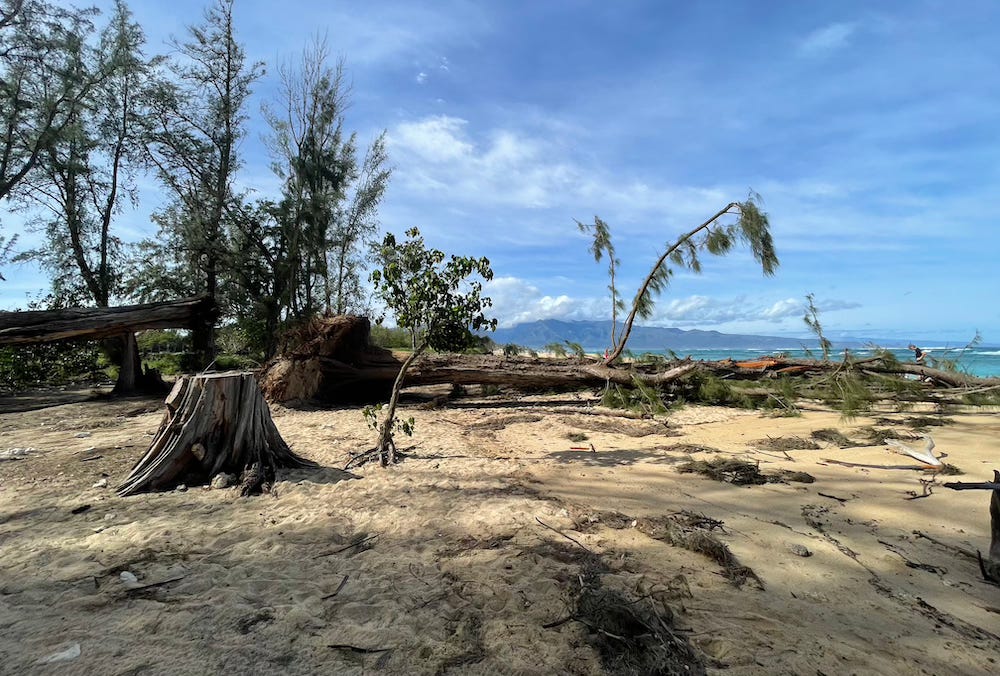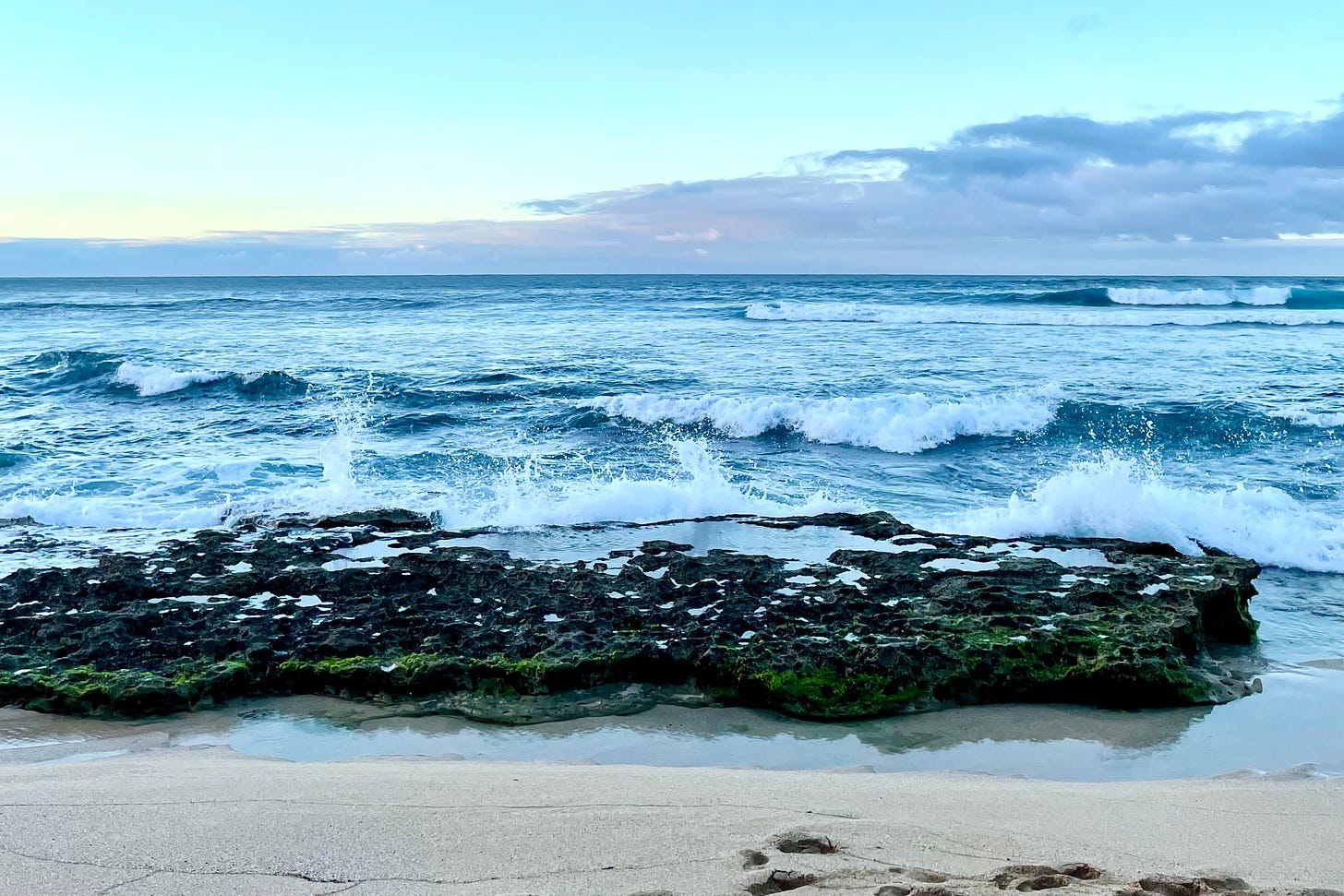The Newsletter is a free, twice-monthly love note for the Anthropocene era. Join our first monthly community chat next week with a paid subscription.
HI
Last week, I stumbled upon that rarity of a conversation so juicy that the interviewee jiu jitsus the spotlight back on their interviewer: In this case, a discussion about “climate delusions” with marine biologist Dr. Ayana Elizabeth Johnson, on The New York Times’ “The Interview”. Midway through their second recording, journalist David Marchese confesses that he gave Ayana a “kind of cockamamie” answer to a very important question she’d asked earlier: “What is it that you don’t want to give up?”
When she poses the question the first time, you can hear David’s sharp intake of breath as the plainness of the query hits him. He speaks about his fear of losing the range of possible futures for his children, ages 7 and 9. When David jokes about this being a selfish concern, Ayana quips, “I assume you care about other people on the planet besides your children…” He returns, “…my wife! [And] you seem nice…I hope things work out for you.” They both burst into laughter.
And then David says, “I just don’t know how to think about the future.” The listener feels for him in this moment: Neither do I, David. Nor do most of us—especially not in the context of the climate realities (extreme weather, sea-level rise, species extinctions, resource depletion, and more) that lie ahead. How are we supposed to know what to make of the future?
I’m reminded of this meme:

Not ten minutes later in the interview, and the second time they talk, David confesses: “I was really thinking…since we spoke…the real answer to why I might be reluctant to change behaviors or be scared of the future…maybe actually has more to do with some selfishness.”
“That’s good of you to admit,” Ayana—author of the forthcoming book What If We Get It Right?: Visions of Climate Futures—offers. “I think we all want to hold onto our comforts.” David, naturally, wants to know if there’s an antidote to this “selfish” instinct, which he allows might just be “human nature”.
Without skipping a beat, Ayana: “I think the answer is community. We have to be responsible for more than ourselves. We have to feel an obligation to more than just our children. It can’t just be a selfish desire to hold on to what we currently have. Which is…illogical because the world is going to change around us, and the things that we have we won’t be able to hold on to.”
“Because we can’t actually control all of society and live in a bubble. You can maybe grip really tightly onto your comforts in the short-term, but the more we resist being part of the collective solution, the less likely that collective solution is to happen.”
The more we resist being part of the collective solution, the less likely that collective solution is to happen. Ayana, dropping the climate crisis mic.
Immediately, I begin to think about my list: What am I afraid to give up? And, relatedly, what solutions do I cling to as a way of appeasing my climate anxiety—telling myself a story about making a difference?
Some things I’m afraid to give up: the immediate conveniences of unlimited, on-demand electricity, water, gas; privacy (I live in a remote area; high density living is far more climate-friendly); my car (I could get an electric one, if I had the budget); fossil fuel-powered travel—I could go on, but the truth that supersedes all these is much simpler.
The thing I am most afraid to give up is the beauty of Earth, of nature, itself—the exquisite wonder that I have been so fortunate to experience. The possibility of permanently losing this beauty, and all the healing sustenance that it offers, is heart-wrenching.
The challenge is, and has been for over a century, that this threat doesn’t yet feel real to many of us. Outside, the sky is often blue, the sun still shines, the moon still rises, the flowers still bloom. We aren’t actively witnessing what we perceive as climate collapse, most of the time. In point of fact: We’re just not aware of what we’re losing. We can’t focus our minds on it. Earth’s beauty is, in and of itself, too much of a distraction. Ironic, that.
A few things I do to appease my climate anxiety: compost and grow some of my own food, drive a hybrid-battery Prius; share resources (food, appliances, skills, and more) with neighbors and community; live far above sea level; not eat a ton of factory-farmed animal products; not buy boxed plant milks (make my own hemp milk instead); not buy period products (use a menstrual cup instead); try to use cloth instead of paper towels whenever possible.

Naturally, these lists are full of contradictions: I may not eat factory-farmed beef but I do buy collagen powder likely made from its discards (no waste?!); I travel without purchasing carbon offsets; I still order stuff from Amazon (it can be hard to access things in Hawaiʻi); I buy plenty of food that’s flown across states and shipped across oceans; I would love to eat completely local but the cost would be at least twice what it is now.
These are big asks to make: That we subvert many of our current hegemonic models of living, which tell us to prioritize (and gauge our success by) the accumulation of individual wealth in order to support a nuclear family, to work as hard as we can so that eventually we can do whatever we want in our retirement. Choosing to be a part of the collective solution likely looks a bit different, involves different kinds of choices, priorities, models of success.
And yet, we’re already witnessing many of the world’s most prominent billionaires buying land to bunker down on for the catastrophes to come. In Hawaiʻi alone, Larry Ellison owns 98% of the island of Lānaʻi, Mark Zuckerberg owns 1400 acres on Hawaiʻi island, Oprah owns about 1000 acres on Maui (part of which operates on its own electrical grid), and Marc Benioff owns about 600 acres on Hawaiʻi island. Of this, Ayana asks: “Is that the life we want to build? Or do we just all try to make sure we have a world where there’s enough for everybody. Where no-one takes too much and we share what we have. I’d rather share.”
I would, too. If only creating the pathways and systems for sharing were as easy as saying so. I still believe in change—if we can keep being honest with each other, keep expanding our collective will for imagination.
As Yuval Noah Harari wrote in Sapiens: “There are no gods in the universe, no nations, no money, no human rights, no laws, and no justice outside the common imagination of human beings.”
SOME HOT LINKS
To read.
Two works of speculative fiction that engage questions of climate and sociopolitical futures:
C Pam Zhang’s Land of Milk and Honey.
Lisa Ko’s Memory Piece.
Give one or both a whirl so we can discuss in the upcoming paid subscriber chat, happening next week!
“The Decade We Almost Stopped Climate Change”—on the period from 1979-1989—is from 2018, but remains an incredible multimedia education.
Loam’s newest publication How Do We Come Together In A Changing World, in collaboration with the Center for Humans & Nature, is only available for preorder until June 1st.
To listen.
“Normal Gossip” delivers a delightful tale of online dating, mushroom foraging, and groupthink.
To watch.
I’ve been very moved by the sensuality and beauty of Suzanne Saroff’s botanical photo and video work—let me know what you feel when you do.
STAY SANE
Consider asking someone you love what it is they don’t want to give up. See where the conversation leads you.
Love,
Lily



Lily, I am so excited you’ve moved your newsletter to Substack! I look forward to the chat next week — I put holds in at my library for both books! :)